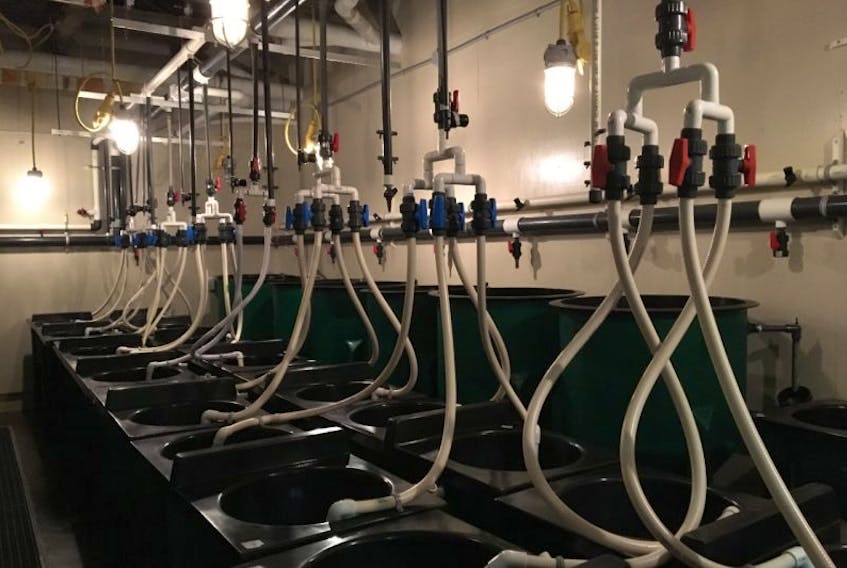
Newfoundland and Labrador has made a dollar on urchins, but could potentially make more in future.
“It needs to have the right shape, the right colour, the right texture and most importantly the right taste,” said Philip James, a scientist with the Norwegian institute of food, fisheries and aquaculture research (Nofima), describing the seafood market demand, at the recent World Seafood Congress in Reykjavik, Iceland.
About 90 per cent of the globally produced urchin gonad — or roe, as is more commonly known — is sent to the Japanese market. It can be hard at times for the world’s producers to source good roe, with urchins plucked from the ocean not always having consistent quantity and quality.
James told his audience about Nofima’s research, including painstaking development of an urchin feed for roe enhancement. Licence to produce the feed has gone to a company called Urchinomics. Working with Mitsubishi, that company’s further work in the United States, Tasmania and Canada is investigating new iterations of the feed and best practices.
The company is working in Eastern Canada, including in Newfoundland and Labrador, under a partnership with Memorial University of Newfoundland.
“I just mentioned Canada because I think that’s the space to watch,” James said of the Urchinomics projects.
•••

The founder of Urchinomics, Brian Tsuyoshi Takeda told The Telegram his interest in Newfoundland and Labrador was actually sparked in Asia.
“It started off as just a chance meet in Hong Kong with Mark Lane,” he said, referring to the executive director of the province’s aquaculture industry association.
He said Lane talked about the province’s green urchins — plentiful in number. He also spoke about the province’s ocean research capabilities and the infrastructure available at Memorial University of Newfoundland.
“Everything was kind of in a tight-knit bundle,” Takeda told The Telegram.
He said he has been encouraged by local industry partners since and by research results to date.
•••
MUN’s Pat Gagnon is leading the urchin work at the Ocean Sciences Centre in Logy Bay.
Tucked in his office, he described for The Telegram a meeting in 2016 where the urchin feed was discussed, along with the pitch —let’s find out if this can work for Newfoundland and Labrador aquaculture. It so happens Gagnon’s Masters and PhD projects looked at kelp-urchin interactions and he took an interest in the feed study.
“It’s turning fundamental knowledge to applied questions for the province. So to me that’s all very exciting,” he said.
He sought funding from the Natural Sciences and Engineering Research Council of Canada (NSERC), with Green Seafoods as a local partner interested in the results, and in March of this year the first experiment was underway.
The research team used urchins taken from the ocean and plumped them up in conical tanks at the research facility, with some at different water temperatures. It’s a trickier business than it sounds, to keep from triggering urchin spawning.
The first experiment ran four weeks. A second experiment ran double the duration.
They were measured for gonad index, or the weight of the gonads set over the weight of the entire urchin. At the time of first collection, urchins for the first experiment were about four per cent roe by weight, but reached about 10 per cent on average after four weeks of feeding. For the second experiment, the urchins started at about six per cent and, after eight weeks, the average was 20 per cent.
“You want to get anywhere between 10 and 15 per cent is pretty much the ideal range,” Gagnon said.
A 24-person taste panel at the Marine Institute suggested the taste, texture and colour could still be improved, but the work continues.
Gagnon said he can’t share what is in the feed, given a non-disclosure agreement. “But I can tell you there’s nothing wrong with that feed,” he said.
A new experiment was already being prepared in September, involving a new version of feed and a water raceway instead of conical tanks, to see if the setting affects uptake and the roe yield. There is a new industry partner and Gagnon is seeking a new round of funding.
“There is something even bigger in the works as well,” he said, explaining he is considering a much larger proposal to examine from the scientific perspective the feed in the urchin’s natural setting.
•••
While excitement builds, there are cautionary tales to be kept in mind in the urchin business. In the 1990s, Maine’s sea urchin industry employed thousands, with harvests peaking at a reported 42 million pounds in a year. Then, populations collapsed.
“There’s a few places where in very shallow water there are some urchins showing up, but you know it’s been decades now. So it’s really a rather significant and protracted decline,” said Bob Steneck, with the University of Maine School of Marine Sciences.
He told The Telegram there was an environmental shift during the heavy exploitation, with more seaweed and a jump in certain crab populations (think Jonah and rock crab versus snow crab). Since tiny crabs eat tiny urchins and grown crabs eat grown urchins, there was an even greater challenge to urchin survival.
“We’ve documented them (the crabs) consuming all of the urchins we’ve brought to a couple of reefs. In two years, we transplanted 51,000 sea urchins and they were all consumed by crabs,” he said.
The potential for change in the ecosystem is something to be mindful of, in the event sudden, expanded demand for urchin production in Newfoundland and Labrador.
“You just simply have to be careful not to exceed the level that you need to maintain the system in its current seaweed state,” Steneck said.
RELATED LINKS
Research underway into N.L. sea urchin farming (Southern Gazette)
http://www.southerngazette.ca/business/2017/3/27/research-underway-into-n-l--sea-urchin-farming.html
Urchinomics
http://www.urchinomics.com/home/
Nofima research: The Urchin Project









